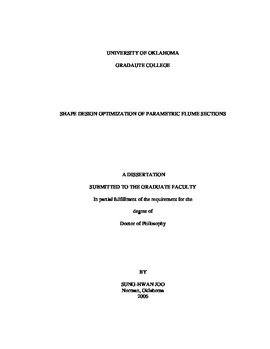| dc.contributor.advisor | Striz, Alfred G., | en_US |
| dc.contributor.author | Joo, Sung-hwan. | en_US |
| dc.date.accessioned | 2013-08-16T12:20:18Z | |
| dc.date.available | 2013-08-16T12:20:18Z | |
| dc.date.issued | 2006 | en_US |
| dc.identifier.uri | https://hdl.handle.net/11244/1057 | |
| dc.description.abstract | This research presents a shape design analysis and optimization methodology for parametric surface flume sections. Flume sections or flow channels have been used widely in many areas such as water chutes in civil and agricultural engineering and water slides and bob sled tracks in the recreational and sports fields. Designing such a flow channel in a CAD environment can provide many advantages such as time and resource savings to the designer. In addition, optimizing such flow channels in a virtual environment is especially efficient. | en_US |
| dc.description.abstract | In this research, geometric modeling was addressed first. Two types of parametric surface flume section models were created: B-Spline-based flume sections and parametric CAD-based flume sections as used in water chutes or water slides. The B-Spline-based flume sections were based on the dimensions of fifteen flume sections, provided by a commercial water slide firm. These flume sections presented the basis for building up realistic flume section configurations. In addition, three different kinds of CAD-based flume sections were developed by the author. Sets of differential equations based on Lagrange's equations of motion were derived that describe the motion of an object traveling in the flow channel. These ordinary differential equations were solved using MathematicaRTM. Continuity requirements were derived from the equations of motion. An analytical shape design sensitivity analysis (DSA) methodology was developed and employed to support the optimization of the B-Spline-based and the CAD-based flume section models. | en_US |
| dc.description.abstract | Optimization of parametric surfaces is a reasonably new area. Although research has been done in this area, most of it has been focused on developing better parametric surfaces, i.e., surface fitting schemes. Here, the B-Spline-based models, based on bi-cubic B-Spline surfaces, were optimized first. The control point positions were used as design variables in the optimization. Using the B-Spline control points as design variables provides more flexibility and allows for local design changes. However, the fact that no CAD software provides the control points as design parameters significantly limits their usefulness in a real design environment. The CAD-based flume section models consisted of sets of key dimensions, which were again defined as design variables for optimization. Using dimensions as design variables provided an easy and realistic avenue for design changes. However, the limited number of dimensions also limits the flexibility of design changes in the CAD-based flume section models. (Abstract shortened by UMI.) | en_US |
| dc.format.extent | xiv, 162 leaves : | en_US |
| dc.subject | Computer-aided design. | en_US |
| dc.subject | Engineering, Mechanical. | en_US |
| dc.subject | Structural design. | en_US |
| dc.subject | Spline theory. | en_US |
| dc.title | Shape design optimization of parametric flume sections. | en_US |
| dc.type | Thesis | en_US |
| dc.thesis.degree | Ph.D. | en_US |
| dc.thesis.degreeDiscipline | School of Aerospace and Mechanical Engineering | en_US |
| dc.note | Adviser: Alfred G. Striz. | en_US |
| dc.note | Source: Dissertation Abstracts International, Volume: 67-05, Section: B, page: 2793. | en_US |
| ou.identifier | (UMI)AAI3218985 | en_US |
| ou.group | College of Engineering::School of Aerospace and Mechanical Engineering | |
